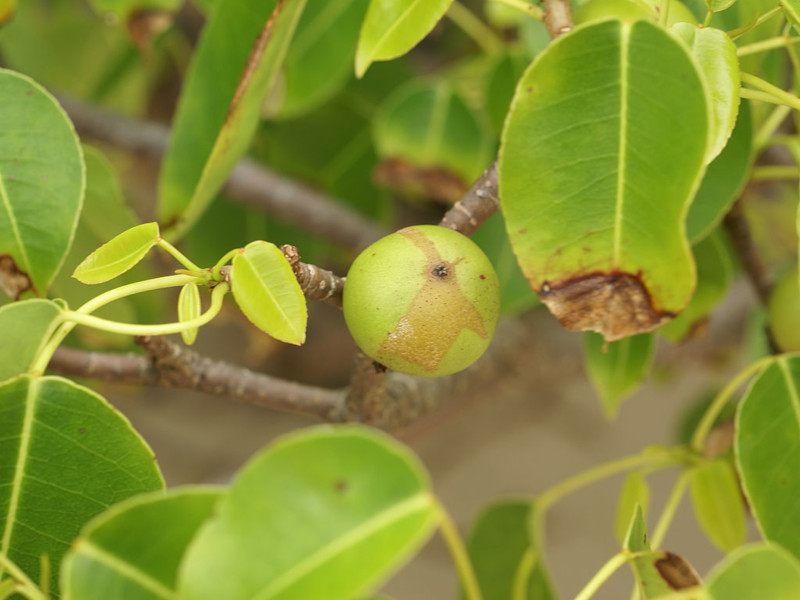
Death Apple Tree Facts
- The term of Death Apple Tree represents only one of the common names applied to this particular variety of tree. The choice does, however, unquestionably form the most attention-grabbing of the several most frequently used names for the fascinating flora.
- Its other names include those of the beach apple and the Manchineel. The official scientific name for the species, though, remains somewhat difficult to pronounce for most of us. That’s because scientists know it as the Hippomane mancinella.
- This spectacular, and surprising, flora owes its original classification to the noted Swedish botanist and zoologist, Carl Linnaeus. The highly respected scientist made the first known formal recognition of it as a separate and distinct species in the year 1753.
- By whatever name one chooses to call it, though, one fact about it stands out from the rest. That’s the fact that it also ranks as toxic in nature. In point of fact, this otherwise lovely plant currently represents one of the most poisonous trees known to man.
- For the moment, the somewhat deceptive Death Apple Tree appears to be maintaining a sufficient and stable population. This trend also seems to hold true throughout the entirety of its native range. The IUCN, therefore, list it as Least Concern on its Red List.
- The plant nevertheless does face certain threats that could change that status in the near future. The chief of these, like many species, remains the danger posed by climate change. It also faces the strong threat of habitat loss, due to man’s ongoing expansion.
Related Articles
Death Apple Tree Physical Description
The astounding Death Apple Tree accomplishes something that not every species does. That’s true since it impresses those who know of it in several different ways. One of those is its sheer size, because mature specimens manage to achieve a relatively significant height.
Exceptional individuals, in fact, attain heights of as much as 49 ft (15 m). That’s certainly not huge, of course, but it nonetheless merits appreciation. The great majority of specimens, however, typically remain somewhat shorter than this in terms of total height achieved.
The bark of the awesome Death Apple Tree, meanwhile usually presents as a reddish-gray in color. Its leaves typically display a finely-toothed structure along the edges. This foliage further averages between 2 -4 in (5 – 10 cm) in length, and develops as a light green in color.
It most highly noted feature, though, remains the one from which its common name derives. That’s its remarkable fruit, which eventually follows its greenish-yellow flowers. While all parts of the tree, remarkably, contain toxins, the fruit remains the most highly toxic.
- Kingdom: Plantae
- Phylum: Angiosperms
- Class: Eudicots
- Order: Malpighiales
- Family: Euphorbiaceae
- Genus: Hippomane
- Species: H. mancinella
Death Apple Tree Distribution, Habitat, and Ecology
Quite fortunately for the flora, the Death Apple Tree evolved as native to a relatively broad section of the world. That region actually covers a significant portion of the Northern Hemisphere. Its population therein, however, remains somewhat scattered in nature.
More precisely, though, it appears in portions of northern South America, Central America, Mexico, the Bahamas, and the Caribbean. A relatively small population of the dangerous but visually appealing tree also appears in part of the state of Florida, in the United States.
Although forced to adapt to other habitats in some locations, it shows a decided preference for where it appears. In the majority of its range, the tree therefore usually grows in one of three regions. These consist of brackish swamps, coastal beaches, and mangrove forests.
The highly toxic nature of the remarkable Death Apple Tree renders it immune to the depredations of most creatures. A few, however, do manage to interact with the tree safely. One species of iguana, in fact, manages to live in the canopy, and also eat the fruit safely.
For most other creatures, though, it’s an extremely hazardous plant. The toxins contained in all parts of it remain quite potent. Its own sap, furthermore, frequently causes severe burns to skin when exposed to it. It’s even been known to occasionally peel the paint off of cars!
Even taking shelter beneath one of these trees in a rainstorm can be dangerous. Exposure to even a single drop, as it absorbs the toxins before falling, will cause the skin to blister. If parts of the tree are burned, exposure to the smoke can also cause severe eye irritation.
Species Sharing Its Range
Check out our other articles on Saint Mary’s Islands, Wood Frog, 6 Geological Wonders of India, Conehead Mantis, Swift Fox, Crocodilefish, Rainbow Snake, Pesquet’s Parrot
